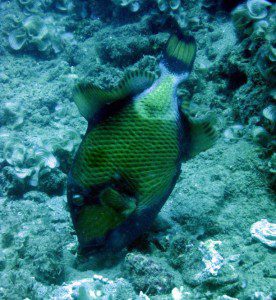By Charlie Gough, Marine Research Coordinator, Belo-sur-mer, Madagascar. Christmas and the New Year was an eventful time for the Blue Ventures Belo sur Mer dive team. Joined by Andavadoaka staff member Goff and BV veteran Dr Garth Cripps, the Belo sur Mer team visited all 7 islands over the Christmas period, conducting annual fish and benthic surveys on 10 reef sites.
The dive surveys were completed over 3 separate weeks, where the team set up camp for 4 days at a time on each of the inhabitable islands of Nosy Andravoho, Nosy Be and Nosy Andriamitaroke. The first week of diving, in Nosy Andravoho saw the best visibility of the three weeks, and included regular sightings of pods of Dolphins, a nesting triggerfish, who each time she left her nest to chase off other potential thieves a cheeky checkerboard wrasse sneaked in to steal a mid-morning snack, and a Discodoris fragilis a peculiar species of nudibranch (Sea slug) which loses large parts of its body when disturbed.
The first week of the New Year the team were grounded in Belo for three days waiting for rain storms to clear, but once they got out to Nosy Be the visibility was still good, and whilst the reefs here are still obviously affected by previous climatic events, corals on some of the reefs appear as though they are recovering, although BV scientist will need more long-term data to determine any significant recovery patterns.
The last week was spent diving on the best of the islands reefs at Nosy Maiheloholo and Nosy Andriamitaroke. These reefs will form the major no take zones or noyaux dur of the Madagascar National Parks Category II Marine Park which aims to protect the impressive biodiversity of these reefs.
The islands are also currently home to a variable number of migrant fishermen throughout the year, and Blue Ventures has been conducting a monthly census for the past year to estimate fishing pressure on these resources. This time of year is widely referred to as “cyclone season”, yet many of these hardened seamen (and their wives and children) remain on the islands in their grass fortresses braving the storms as they come down the Mozambique channel, in order to continue fishing for the much sought after shark fins and sea cucumbers.
The effects of climate change are apparent on many of these islands; large boulders of corals are washed up following the ever more frequent and destructive tropical storms and erosional processes have removed a large section of Nosy Andravoho. The more diverse reefs of the southern islands appear to have survived (either by chance or natural resilience) recent climatic events, and have recovered well following the bleaching event experienced earlier in 2009 where scientists observed upto 80% of bleached coral colonies, including the generally more resistant Porites sp.



